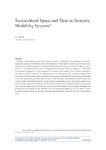Sociocultural space and time as semiotic modelling systems

View/
Use this link to cite
http://hdl.handle.net/2183/13404Collections
Metadata
Show full item recordTitle
Sociocultural space and time as semiotic modelling systemsAuthor(s)
Date
2012Citation
Culture of communication / Communication of culture, 2012: 999-1008. ISBN: 978-84-9749-522-6
Abstract
[Abstract] In the paper I discuss how time as a sociocultural category is modelled by space and spatial concepts. I explain the mixed use of different object- and metalevels of descriptions of space at the construction of concepts of time and temporality at the interpretation of the sociocultural world. The "cognitive turn" in studies of culture and society has been accompanied with the risen focus on metaphor — descriptions of metaphoric processes as a main mechanism of culture on the object level of studies, metaphor as metalingual concept, metaphor in the metalanguage and the discussion on the concept of metaphor itself. Starting from the biosemiotic basis of cognition, through the interpretations of social practices (activities, events and their relations as social basis for 'time'), 'time' and 'space' become abstract notions. Space and time are semiotic modelling systems involving several (intermingled) relative object- and metalevels and are thus widely applicable modelling tools. The use of space to model temporal concepts and the mixed use of different modelling levels of one and the other, and the (over)use of the concept of metaphor, rises doubts about the 'temporality' and 'spatiality' of sociocultural phenomena (e.g. the city and its history) as well as about the ability to share the knowledge among different studies on time in the sociocultural field.
ISBN
978-84-9749-522-6





